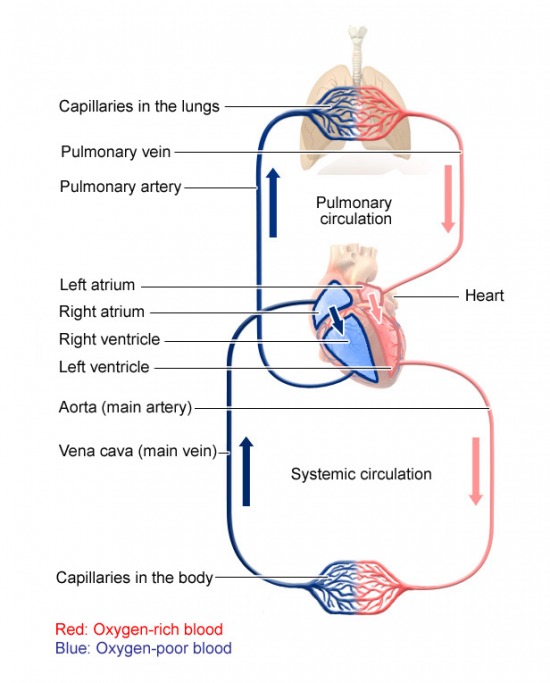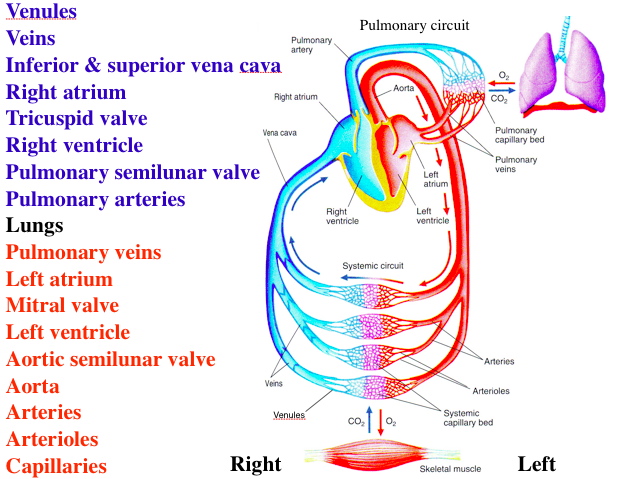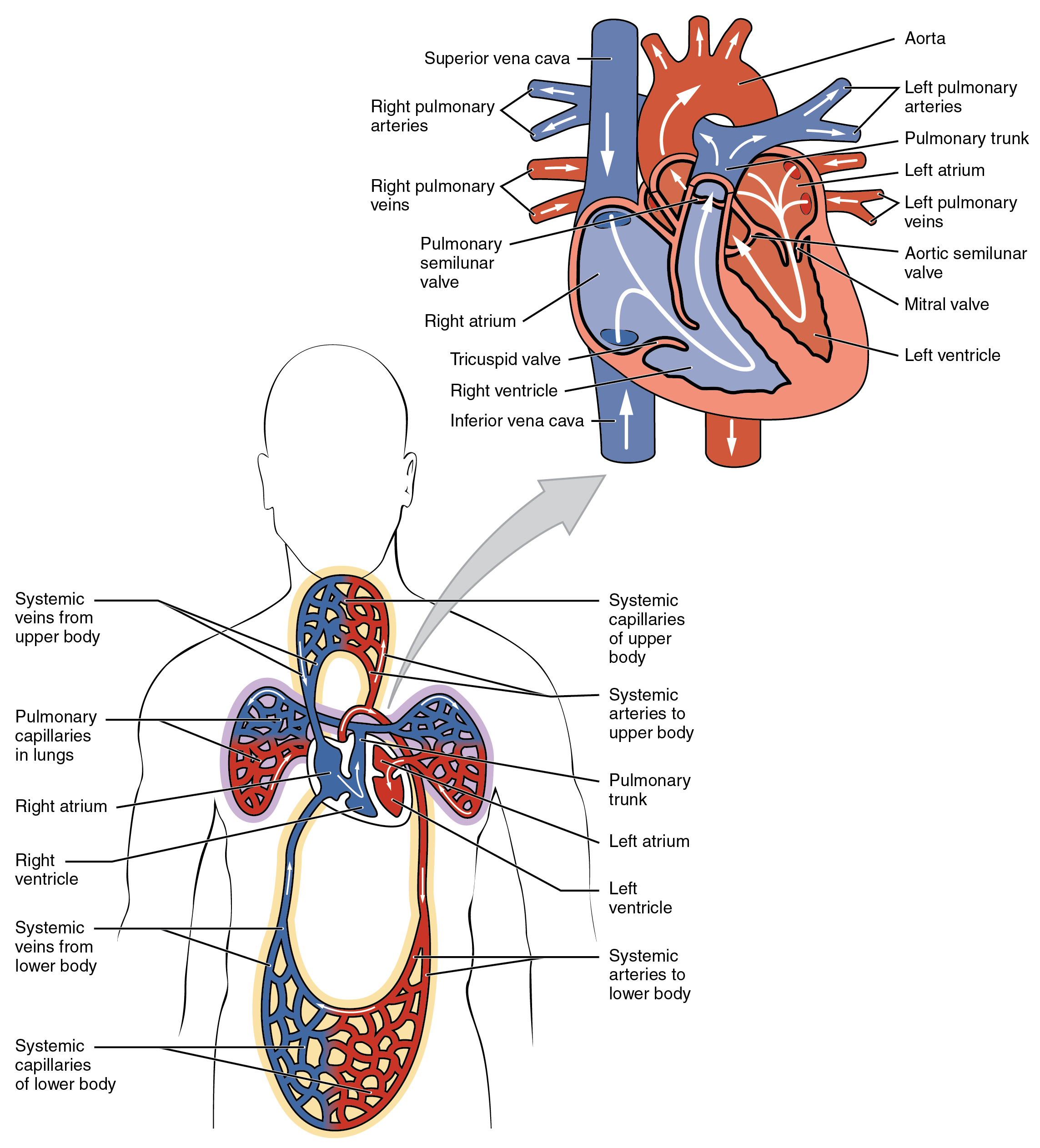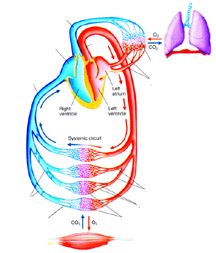The Systemic Circuit Is Best Described as
This blood is circulated from the aorta to the rest of the body by various major and minor arteries. Module 191B Describe the systemic circuit.

What Is The Path Of Blood Through The Circulatory System
The circulatory system is divided into two phases in the human body.

. It transports deoxygenated blood to the lungs to absorb oxygen and release carbon dioxide. In a closed circulatory systems the heart pumps blood through vessels that are separate from the interstitial fluid of the body. The venae cavae carry low-oxygen blood to the right atrium of the heart.
Systemic circulation carries oxygenated blood from the left ventricle through the arteries to the capillaries in the tissues of the body. After moving through the pulmonary circuit oxygen-rich blood in the left ventricle leaves the heart via the aorta. The oxygenated blood then flows back to the heart.
In the systemic circuit active hyperemia is best described by increased metabolic activity that results in vasodilation. It transports oxygenated blood to virtually all of the tissues of the body and returns relatively deoxygenated blood and carbon dioxide to the heart. Blood is pumped from the left ventricle of the heart through the aorta and arterial branches to the arterioles and through capillaries where it reaches an equilibrium with the.
Dense bands of tough elastic tissue that encircle the heart valves. The systemic circulation provides the functional blood supply to all body tissue. Systemic circulation in physiology the circuit of vessels supplying oxygenated blood to and returning deoxygenated blood from the tissues of the body as distinguished from the pulmonary circulation.
What best describes the term electric current. In contrast the pulmonary circuit refers to the path from the right ventricle through the lungs and back to the left atrium. The Heart Powers Both Types of Circulation.
This will allow the ice sheets in the polar regions to increase increasing also albedo. Which of the following best describes systemic circulation. The systemic circuit involves pumping out blood from left ventricle through aorta to body parts and its return through vena cavae inferior and superior to right atrium.
Active hyperemia is the increase in organ blood flow hyperemia that is associated with an increased metaboli. Up to 25 cash back The largest artery in the systemic circuit is the aorta. On the evolutionary cycle pulmonary circulation first occurs in lungfishes and amphibians the first animals to acquire a three-chambered heart.
Complete separation of oxygenated and deoxygenated blood has enabled the high metabolic rates found in todays birds and mammals. Here blood entered the heart twice and left it twice. Up to 10 cash back The systemic circulation refers to the path that carries blood from the left ventricle through the body back to the right atrium.
The arteries capillaries and veins of the systemic circulatory system are the channels through which this long journey takes place. The evolution of a septum in the ventricle compartment of the vertebrate heart evolved in some reptiles and mammals possibly independently. Module 191B The systemic circuit transports blood from the right ventricle through the pulmonary arteries capillaries in the lungs and pulmonary veins and returns it to the left atrium.
What Is a Systemic Circuit. It sends oxygenated blood out to cells and returns deoxygenated blood to the heart. Describe the systemic circuit.
Decreased deforestationincrease in aforestation increases the earths. Systemic circulation moves blood between the heart and the rest of the body. Using light-colored building materials on houses and pavement in urban centers will work towards increasing albedo as more sunlight is refelcted back by built environments.
The blood vessels in the cardiovascular system are subdivided into three circuits known as the _____. Blood pressure drops with distance from the left ventricle. Which of the following best describes a systemic circuit.
The femoral artery is a major systemic artery found in the leg and thigh. Systemic circuit is defined as one of the two circuit of circulation that occurs in human body. In the systemic circulation blood travels out of the left ventricle to the aorta to every organ and tissue in the body and then back to the right atrium.
It carries oxygen and nutrients to the cells and picks up carbon dioxide and waste products. The cardiac skeleton is best described as _____. The systemic circuit is that part of your circulatory system that carries blood away from your heart delivers it to most of your organs and tissues and returns it to.
The portal system drains blood from the capillary beds of the digestive tract to a capillary bed in the liver. The flow of electronsElectric current is the rate of charge or flow past a given point in an electric circuit. Which heart chamber has the thickest muscular walls.
Most vertebrates and some invertebrates like this annelid earthworm have a closed circulatory system. Pulmonary circulation system of blood vessels that forms a closed circuit between the heart and the lungs as distinguished from the systemic circulation between the heart and all other body tissues. The systemic circuit is the path of circulation between the heart and the rest of the body excluding the lungs.
It transports blood to and from the lungs where it picks up oxygen and delivers carbon dioxide for exhalation. Blood circulation from the_____ - 6789582. In b open circulatory systems a fluid called hemolymph is pumped through a blood vessel that.
Answer 1 of 2. Systemic circuit uses the left side of the heart to deliver oxygen-rich blood from the lungs to the body four pulmonary viens bring blood back from the lungs to the left atrium brachiocephalic artery braches to form right subclavian and right common carotid arteries internal carotid artery supplies the brain external carotid artery.

Blood Flow Through Systemic And Pulmonary Circuits

Bio121 Systemic And Pulmonary Circulations Flashcards Quizlet

Heart Anatomy Anatomy And Physiology
21 3 Mammalian Heart And Blood Vessels Concepts Of Biology 1st Canadian Edition

Lesson Explainer The Heart Nagwa

Seer Training Circulatory Pathways

Chapter 19 20 21 Flashcards Quizlet

Lesson Explainer Circulatory Pathways Nagwa
21 3 Mammalian Heart And Blood Vessels Concepts Of Biology 1st Canadian Edition

What Is The Pathway Of Blood Through The Heart Byju S Neet

Solved C The Pulmonary And Systemic Circuits Blood Flow Chegg Com

Pulmonary Hypertension Clinic The Heart Center

Blood Flow Through Systemic And Pulmonary Circuits

Systemic Circulation An Overview Sciencedirect Topics





Comments
Post a Comment